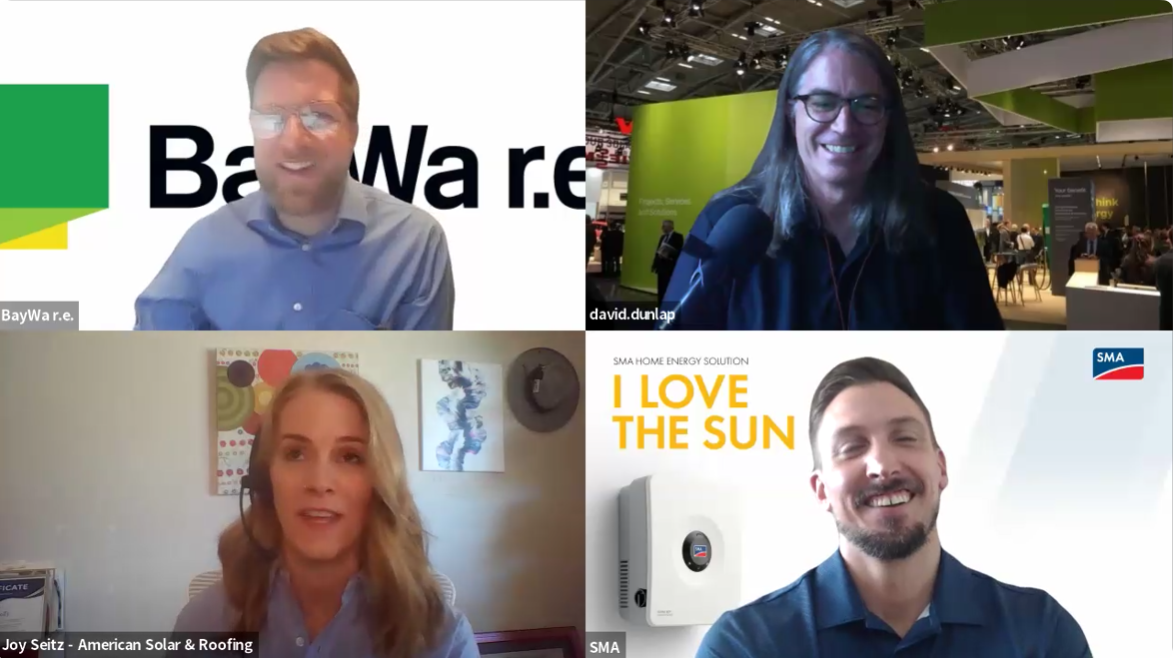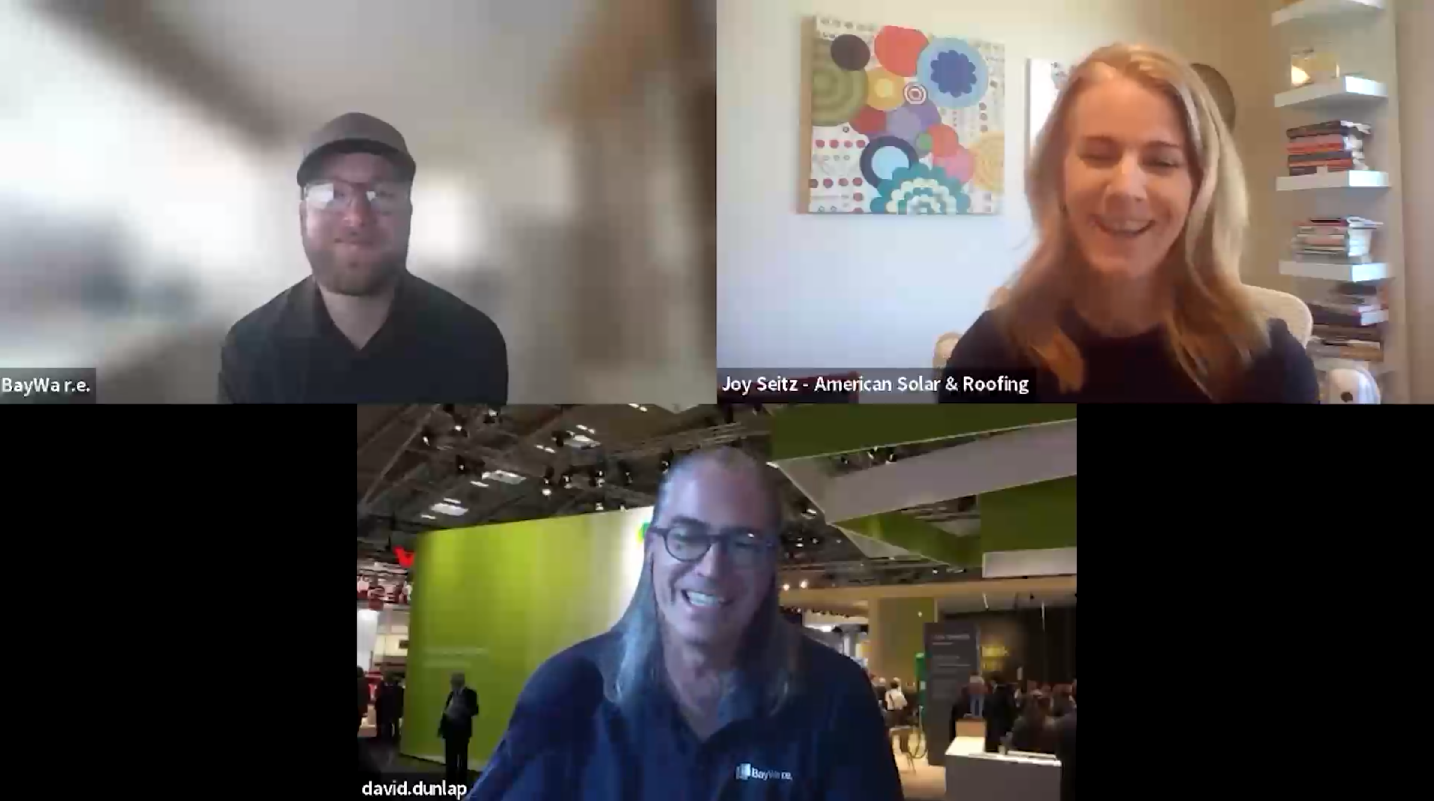Launched during the start of the pandemic, our BayWa r.e. Solar Town Halls continues to bring U.S. solar contractors and industry leaders together to discuss the rising challenges and opportunities in the business of solar installation and deployment.
Whether you serve the residential homeowner market, or focus on commercial and industrial projects, spend an informative hour with industry insiders and hear how you can keep pace with changes within the solar financing landscape. Our expert roundtable this month covers everything:
- The impact of supply chain disruption and labor shortage
- The untapped opportunity for small to medium commercial solar
- The long road to standardized processes.
How policy differences across jurisdictions affect financing options
The importance of transparency and education for homeowners and for commercial stakeholders
New to BayWa r.e.?
Here are 10 reasons why more solar contractors are choosing BayWa r.e. Connect with our team today.
Michelle Davis, Principal Analyst on U.S. Distributed Solar at Wood Mackenzie Power & Renewables
Bryan White, Research Analyst at Wood Mackenzie Power & Renewables
Gregg Fisher, Senior Director of Business Development at GoodLeap (formerly LoanPal)
Brad Ferrell, CEO of Enable Energy, part of the BayWa r.e. Global family of renewable energy companies
Rachel Schapira, Director of Residential Finance here at BayWa r.e. Solar Systems / US
Guillaume Casanova, Director of Commercial Solutions here at BayWa r.e. Solar Systems / US
2021 IN CONTEXT FOR SOLAR FINANCING
Commercial solar (including community solar) is expected to experience an overall 17% of growth in 2021, and residential solar is forecasted for 19% of growth this year. These were the promising prognostications that led off our Solar Town Hall show, as reported by Michelle Davis, Principal Analyst on U.S. Distributed Solar at Wood Mackenzie Power & Renewables, and by Bryan White Research Analyst tracking residential solar at Wood Mac.
Some of the commercial boost has simply been due to timing, as community projects finally come online. The forecast for commercial may temper down the road, however. “We’re expecting a little bit more moderate growth in the more like 6 to 7%,” said Michelle Davis. “Basically, you’re looking at somewhere between 2.6 and 2.8 gigawatts of commercial solar coming online every year for the next several years. And of course, logically there’s a little bit of an expected dip in 2024 when the EITC reduces to 10%.”
On the residential side, the demand for solar is higher than ever. “The industry showed a lot of resilience — and of course we’re still in the pandemic, but companies have really started to find their footing beginning of this year if they hadn’t already,” commented Bryan White. “Sales are really returning back to normal levels. Activity is really picking up. But I think the biggest question here is how much are sales outpacing installations, and how installers can manage their project pipelines.” Both important keys as we open our conversation on financing.
“Commercial solar (including community solar) is expected to experience an overall 17% of growth in 2021, and residential solar is forecasted for 19% of growth this year. ”
— Michelle Davis, Principal Analyst on U.S. Distributed Solar at Wood Mackenzie Power & Renewables
GLOBAL DISRUPTION IMPACTS ON SOLAR FINANCING
The pandemic — and its economic and human capital fallout — adds another dimension of context for the solar financing market as well. Our Director of Commercial Solutions Guillaume Casanova mentioned that this summer, installers were having a hard time finding staff to complete installations, on top of logistics delays for trans-Pacific shipping. “That causes delays in projects to slip and their timelines to potentially move to 2022,” said Casanova. These extended lead times have stretched out for larger commercial projects to 18 to 24 months, said Brad Ferrell, CEO of Enable Energy, which joined the BayWa r.e. Global family of companies in 2020. “So, you could have stranded capital sitting in a project, where you’re tied to a PTO milestone — and you’ve got to be very conscientious of that going into a project specific on the commercial side,” Ferrell commented.
Our Director of Residential Finance Rachel Schapira pointed out another unintended consequence of these global delays and price increase dominoes. “There are a number of EPC’s who have set pricing with their originators that don’t allow — or aren’t built for — for the very variation where equipment prices go up, because prices have been going down for so many years,” observed Schapira. “We are expecting prices to start going up on a number of components. And I think a number of EPC’s who have not factored in the possibility of prices going up into their contracts with originators are going to find themselves in a tight financial pinch.”
That could additionally put some newer solar players — sales organizations that have transitioned into EPC’s — at a further disadvantage. “They’ve never known product constraints, or human capital constraints,” said Gregg Fisher of GoodLeap LLC, a home and solar financier and a BayWa r.e. Split Pay Program partner. “The folks that went from 15 to 30 installations a month —and now they’re trying to figure out how they keep up with that.”
“We are expecting prices to start going up on a number of components. And I think a number of EPC’s who have not factored in the possibility of prices going up into their contracts with originators are going to find themselves in a tight financial pinch.”
— Rachel Schapira, Director of Residential Finance, BayWa r.e. Solar Systems
WHO WILL FINANCE THE SMALL-MEDIUM COMMERCIAL MARKET?
“I definitely witnessed the inability to tap into the small and medium commercial segment as being probably one of the biggest pain points for the commercial solar industry,” said Michelle Davis, who notes there is a mismatch between what that capital is looking for — versus the small and medium businesses or smaller projects that actually fit the criteria to get any kind of PPA financing from some of these capital providers.
“The overlap between those two spaces is still quite narrow — and it’s highly, highly fought over,” said Davis. “I think a real area of focus for this industry to tap into that addressable market more would be things like lowering transaction costs — and having a better alignment between what financiers are looking for in some of these projects, and maybe deal sizes that can be aggregated. There are some folks that are working on this, but it’s still very slow going.”
Brad Ferrell does have one recommendation solving this pain for financing small commercial systems: traditional bank financing. Ferrell says with small repeatable projects — 250 kilowatts and below for example — financiers could take them on if they’re a repeatable footprint client, perhaps a gas station that has 10 locations or a similar scenario. “But the problem is that nobody is focused specifically on that market successfully in any scale,” said Fisher. “That has low transactional cost structures and an easy rinse-and-repeat process.”
“There is a huge void — I mean an absolute void in small commercial opportunity that is just sitting out there for someone to go solve.”
MAKING THE CASE FOR YOUR PROJECT
Global disruptions and policy hurdles aside, in the end, it really comes down to making the case for solar to all parties involved, from the property owner to the financier. And our panelists all agreed that it pays to understand each audience — and to communicate and educate on these risks and rewards with transparency and clarity.
For some businesses looking into solar investments, the value proposition could go beyond operating savings and more into brand reputation. “How can we translate that more to them, whether it is a consumer benefit that can be visible in their product packaging, or whether it’s a kiosk and their entry of their facility to highlight their engagement in renewable technology,” suggested Brad Ferrell. And of course, operating costs are important, too. “Draw their attention to where they’re spending their money today — in an area that they’re not thinking about — in a way that they could save money in this cost,” added Rachel Schapira.
The nuance, though, is that many commercial businesses are completely unfamiliar with all the equipment and cost lines within a solar project. Guillaume Casanova makes a good point about stakeholder education. “If you take the example of a baker, you show them a fridge and they know what’s going to yield in terms of revenue for them,” explained Casanova. “But if you put a $300,000 solar system on the roof, and it sits on the balance sheet and you have issues – what is an inverter? And when it fails, what do I do and why is my system going down? So that is important.”
Michelle Davis emphasized this point about clear communication and transparency with the commercial solar customer. “I think one of the biggest, most difficult challenges with commercial customers in particular is that they’re not energy experts — they’re not solar experts,” said Davis. “So if they’re going to be making this big investment, potentially putting a big loan on their balance sheet, they want to at least have a general understanding of what the investment is and what the asset is. And I feel like that customer education gap is very tricky and very challenging.”
“We’re seeing two tracks right now [in residential finance]. One is innovation, where the homeowners have options as to how much they want to pay and when, or being able to bundle more services into a single loan. The other is competing on rates, with providers even offering as low as a half a point APR in some cases.”
— Gregg Fisher, Senior Director of Business Development, GoodLeap
CHOOSING BETWEEN RESI FINANCING OPTIONS
So, what should solar contractors be thinking about when choosing from the various types of residential financing avenues out there, be it loans, leases, PPA’s, or else? First, residential solar contractors should ask themselves whether they’re happy with their close ratio. “The primary purpose of all these products is to expand their addressable market and improve their close ratio — so they can grow their business better and make their product available to more consumers,” said Schapira. “The next thing I would think about is how much paperwork or administrative burden their team can handle. Generally speaking, leases and PPA’s are more demanding in terms of the paperwork for installers.”
Residential contractors should consider each financing avenue in terms of their value to homeowners as well — since they are the key factor in all this anyways. “Do an evaluation of what generates the most savings for the homeowners they serve, and think about who they’re targeting in their marketing efforts,” reminded Schapira. “Because different homeowners are going to derive different benefits from the different products.”
Fortunately, there’s help. “We’re seeing two tracks right now,” observed Gregg Fisher, regarding improvements in the resi financing landscape. “One is innovation, where the homeowners have options as to how much they want to pay and when, or being able to bundle more services into a single loan.” The other is competing on rates, with providers even offering as low as a half a point APR in some cases. “So, I think there’s a solution that the market has for almost every homeowner situation,” said Fisher. “I think one of the things that we are trying to do a better job as a segment in the residential space is not just helping salespeople understand how to qualify a home or for solar — but what are the right questions you can ask to make sure you’ve got a product that works for them.”
CHANGING THE MARKETPLACE
So how can we encourage more players and options on this complex landscape of solar financing? One aspect might simply be the eventual preponderance of good, supportive numbers. “I think as time goes on, there’s going to be more performance data available showing that repayment rates are really solid,” mentioned BayWa r.e.’s Rachel Schapira, especially since solar isn’t a whimsical, luxury purchase. “The solar industry has always expected repayment rates to be really solid on these products — and the more time goes on where these products exist longer, the more data we have available and the more data we have available, the more we can make the case to capital markets that we can reduce how much they need money that they need to set aside to kind of protect against losses.”
The other is changing how financing is done and encouraging more standardization to the process. “In the hundreds of deals — over a thousand in my career — financing never goes smoothly,” laughed Brad Ferrell. “Some times are smoother than others, but it’s never walk up to the counter, fill out the documents, get it processed, and we’re done.” This also comes back to transparency for the client, and disclosing to the client the steps of the financing process. “Ultimately that customer is going to be living with that [financing] provider,” said Ferrell. “You’ve got to have that relationship develop over the course of the transaction, or it will not be a healthy relationship long-term.”
“The lack of standardization in commercial solar is very challenging. Every deal has unique characteristics for financing, for customer acquisition, for technology or project design itself,” added Michelle Davis. “It definitely makes it a tougher business, and you can see that in the numbers: there’s just a lot less megawatts of small and commercial, small and medium commercial solar installed today.”
Platform innovations may also change the playing field someday. One example is Open Energy Group, mentioned by Michelle Davis. “They have an online marketplace, and developers can put their project portfolios up into the platform,” Davis described. “What’s nice about it is that one of the things they’re trying to achieve is some standardization. You can compare across different projects and across developers — and then presumably those can be matched with asset owners, and enter into bidding processes.”
DOING YOUR PART
At the end of the day, there’s one other tool for navigating these financing landscapes that every contractor and EPC has: their own homework and enterprise in building relationships with finance partners. “What is good for a company in the EPC space for commercial is a healthy two-way relationship with financiers,” encouraged Brad Ferrell. “Many financiers are out there developing their own projects as well, and they need good regional players to fulfill those construction services.”
Ferrell reminded our audience that this trust works both ways. Your company may need that financier to complete your sale and lock up your project. But your business record is in itself of value to financiers looking for steady partners to attack and saturate a geographic market, and to avoid one-off partners and random locations.
“In developing your PPA strategy or third-party ownership strategy, definitely come at it from that approach — that ‘We are here to bring you opportunity, but we’re also here to assist you in this market,” said Ferrell. “That’s a good, healthy balance for any business in the construction world to have — opportunities coming in from both directions.”
Missed one of our events? Access all of our expert roundtables in our Solar Town Hall archives, find video excerpts on YouTube, and take podcast versions with you on the go via Spotify, Apple, or Google.
BayWa r.e. Solar Systems LLC supplies residential and commercial solar installers in the United States with quality solar + storage components, forecasting, business planning advice, and a community of experts. Visit www.solar-distribution.com to read our industry insights articles and stream our Solar Tech Talk and Solar Town Hall podcasts on YouTube and Spotify. Follow us on LinkedIn, Twitter, and Facebook to stay connected. Ask us about our Split Pay financing program and use our industry-leading Webstore to save time, get gear shipped, and get jobs done! Part of the BayWa r.e. Global family of renewable energy companies.
Subscribe to our newsletter
Stay up to date on the latest industry news, new product releases, BayWa r.e. news and more when you subscribe to our monthly newsletter.




